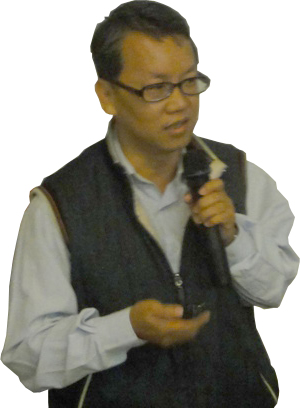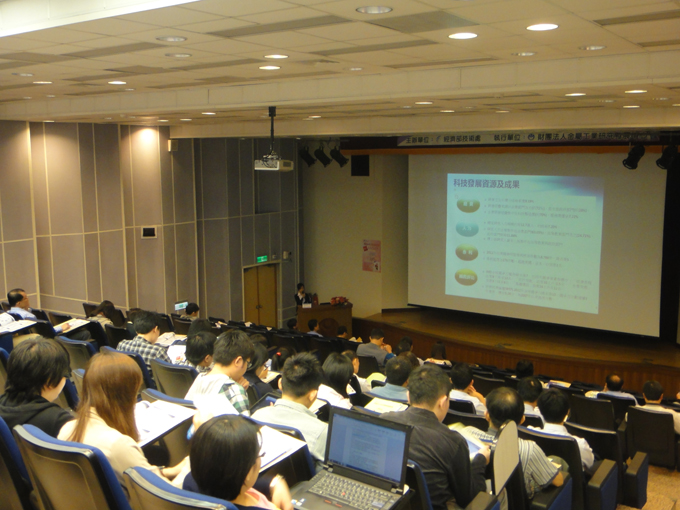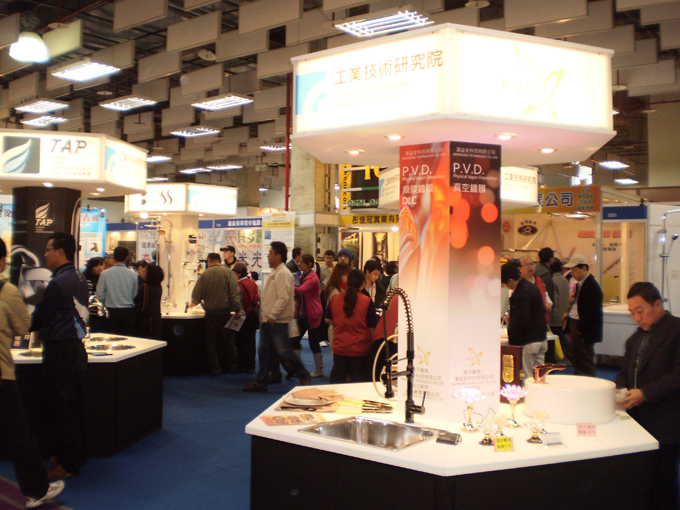Taiwan's Traditional Manufacturers Need Soft Power to Upgrade
One obstacle being inadequate investment in R&D by Taiwanese makers
2013/04/16 | By Steve ChuangSoft power has been a buzzword in Taiwan, whose export-driven economy is gradually changing and needs sustainable development when cost cutting is no longer sufficient, and when knowledge is essential to stay ahead; and accordingly, traditional manufacturers are eagerly looking to upgrade into value-added production in the face of increasing competition from emerging economies.

To promote the latest technology-development white paper issued by the Ministry of Economic Affairs, the Taiwan Institute of Economic Research held a seminar in November 2012 and invited Y.C. Dai, a senior manager of the metal product R&D department of the Metal Industries Research & Development Centre (MIRDC), along with C.C. Lee, a sector chief of the Taiwan Design Center, and Red-Tom Lin, manager of the Technology Marketing Dept. of Industrial Technology Research Institute (ITRI), to shed light on the current situation of traditional manufacturing and offer suggestions to the government to help with soft power enhancement.
Slow Development
Dai summed up the development of Taiwan's traditional manufacturing industries, and said that soft power is the ability to innovate products and services or other factors that enhance technological advancement, which can involve R&D, ICT (information and communication technology) application, branding, corporate operating models, latent incubation, supply-chain networks, organizational efficiency and so forth.
“After experiencing brisk economic growth driven by rapid development of local production-oriented and capital-intensive industries in the past decades, Taiwan needs to restructure its economy to maintain momentum,” said Dai.

Dai pointed out that soft power, or multifactor productivity, has already contributed 43.5% to Taiwan's economic growth in the early 21st century to top corporate contributions in manpower and capital investment, according to statistics issued by the Directorate-General of Budget, Accounting and Statistics. He stressed that the island still has room to develop soft power to better build local industries, given that developed countries have even higher contribution rates of multifactor productivity to economic growth.
Compared to Taiwan's 4.4% GDP growth against only 43% in multifactor productivity's contribution, Germany, Japan, and S. Korea, for instance, posted 0.9%, 1.2% and 3.8% economic growths, respectively, against soft power contribution rates of 66.7%, 100% and 73.7% during 2000-2010, said Dai, citing statistics from the Organization for Economic Cooperation and Development's structural analysis database (OCED STAN Database).
In terms of maturity of local corporate management, which helps to enhance productivity and can indicate soft power of a firm, Dai added, Taiwan's industries in fact have moderate development of soft power. According to WEF's Global Competitiveness Report, Taiwan ranked 13th in 2011 among 142 countries in terms of corporate maturity, falling one notch compared to 2008's, while emerging countries, including China, Malaysia and Brazil significantly advanced to 37th , 20th and 31st , respectively. Notable is that Taiwan dropped to the 16th place in corporate productivity, and plummeted to 22nd in international logistics, but remained atop the 146-nation rankings in industrial cluster development.
“About 98% of Taiwanese enterprises are small and medium-sized,” said Dai, who blames lack of resources for the relatively modest development of soft power.

Structural Problems
Dai focused on some structural problems related to supply and demand in Taiwan's traditional manufacturing industries that hamper development of soft power and value-added production.
Firstly, Dai said, Taiwanese makers use too much material as intermediate input and mostly neglect the importance of inputs of services. According to OECD STAN Database, raw materials accounted for about 45% of overall intermediate input in production of other goods in Taiwan in the mid-2000s, when these proportions in Japan, Germany, the U.S. and the U.K. stood at only 24%, 18%, 18% and 16%, respectively. This weakness undermines added-value of Taiwan-made products, which was especially significant 2002 through 2008, when raw material shortages caused skyrocketing prices.
Dai stressed that global industrial development has shifted from traditional manufacturing economies to balancing production and services to enhance added- value of manufacturing industries through support from service providers. However, he said, most Taiwanese traditional manufacturers had only 15% of intermediate inputs being services in mid-2000s as shown by OECD STAN Database, hence failed to build positive links with service providers, except distributors and retailers. This situation hinders producers from enhancing added-value of products, though today 70% of Taiwan's GDP is generated by services.
Meanwhile, Taiwanese traditional producers spend moderately on R&D. According to Dai, only 20% of total R&D spending by Taiwan's manufacturers a year is from traditional makers, who, according to MIRDC's surveys, typically pour NT$2 out of every NT$100 earned on average into R&D, compared up to NT$7 by their counterparts in Japan, Germany and the U.S. Also notable is that local traditional makers in Taiwan apply fewer ICTs as intermediate inputs in production than those in other developed countries, despite the island's well-developed ICT industries.
Dai also listed other factors troubling Taiwanese traditional manufacturers to develop soft power and value-added products, including lacks of unique products and market-driven design concepts, slow development of new products, neglect of capital expenditure in R&D, poor technology integration capability for trial production, backward development of manufacturing processes and forming technologies compared to state-of-the-art ones in developed countries, low self-sufficiency in supply of key components, ineffective integration of cross-sector manufacturing, few logistic warehouses overseas, incapacity in building owned global distribution networks and modest branding and marketing.

Suggestions
Based on MIRDC's experience, Dai offers several suggestions to the government and enterprises in nurturing soft power and upgrading production.
Considering that Taiwan has 82 distinctive industrial clusters mostly in northern, central and southern regions, Dai said that the government should promote existing regional R&D centers to more than drive R&D momentum into local industries, but also link mutually to form value-added supply chains and develop different higher-end products according to industrial and regional characteristics.
For instance, one center in Taiwan's central county of Chiayi, which is noted for boutique farming, food-making, cosmetics, and green energy, has been working on horizontal and vertical integration of these industries in cooperation with several R&D bodies, aiming to establish cross-sector platforms for enhancing technology exchanges and latent incubation, as well as develop high value-added technologies and products, such as biotechnology and higher-end precision machinery, by tapping synergy.
To speed up development of traditional manufacturers' soft power, Dai suggests that regional R&D centers help manufacturers to apply technologies to enhance R&D capability, build long-term industry-academia partnerships to broaden use of applied technologies, and integrate ICTs and services into manufacturing to create new B-to-B business models.
Governmental Resource
Dai furthered that companies should actively take advantage of government's resources through applying for and carrying out TDRs (technology development programs) or SBIR (Small Business Innovation Research) programs in cooperation with local research institutes to develop new products and strengthen R&D capabilities.
The partnership between R&D bodies and manufacturers of faucets and bathroom fittings in Changhua, central Taiwan, is a striking example of soft power development, mentioned Dai. Dingfanpo, a small borough of Lukang Township in Changhua, has the highest density of faucet manufacturers in Taiwan, but most are small-sized, inept at technology integration and lack capabilities to develop innovative products and mechanisms to start trial production.
To solve the abovementioned problems, some research institutes help operators develop new rapid prototyping processes, as well as improve plastic injection molding, die casting, pressing and mass manufacturing capability to speed R&D process. Meanwhile, operators focus on developing and applying value-added technologies, such as integration of a digitally controlled and monitoring water supply system into faucets, drawing on cross-sector partnerships. The industry is also served by an information-exchanging platform and market information provided by R&D bodies to boost global presence and marketing skills.
So far the partnership have borne fruit, as R&D time from designing and shop drawing to mass production has been shortened by 30%, added-value of faucets raised by 10% thanks to use of newly developed processing techniques, and costs of product certification reduced by 50%, said Dai, who added that Taiwan' faucet industry has regained lost ground to enjoy higher profile globally.
Another ongoing soft power development program by Taiwan's R&D institutes focuses on the industry of bags and cases, which has been plagued by the lack of latent cultivation of fashion design concepts, capability of applying automated production technologies and prototyping and supply of value-added materials. So, with assistance from R&D bodies, the industry is introducing CAD (computer aided design)/CAM (computer aided manufacturing) technologies and new stitching, laser processing, printing and rapid prototyping techniques, as well as building a database of customs and fashion information, which is shared via cloud by operators.
Alliances
Dai also thinks that alliances initiated by industry-leading companies and upstream material suppliers are effective to upgrade traditional manufacturing industries.
For example, China Steel Corp., the largest steelmaker in Taiwan, has inaugurated several R&D alliances to develop cutting-edge materials, such as titanium and silicon steel sheets, to help fastener makers, household appliances suppliers work out valued-added products, according to Dai.
Also, an alliance led by Taiwan's largest yacht hardware supplier Aritex Products Co., Ltd. in cooperation with MIRDC focuses on development of electromechanical integrations for yachts, instead of traditional manufacturing techniques, to better tap the market trends for electronic and HID (human interface device) technologies that are increasingly demanded by yacht owners for more convenient boating and effective monitoring of yacht's conditions.
| Major Industries (Industrial Clusters) in Taiwan by Region | |
| Region | Industry |
| Northern Taiwan | Ceramics, knitted fabrics, medical instrument, household appliances, textured yarn, automotives, printing, dyes, metal molds, etc. |
| Central Taiwan | Textile, sports equipment, furniture, household appliances, footwear, tires, hand tools, machine tools, bicycles and related parts, faucets and bathroom fittings, etc. |
| Southern Taiwan | Frozen meat and seafood, animal feed, glasses, leather, herbal medicine, petroleum, steel, fasteners, yachts, auto parts, plastic and rubber machines, etc. |




